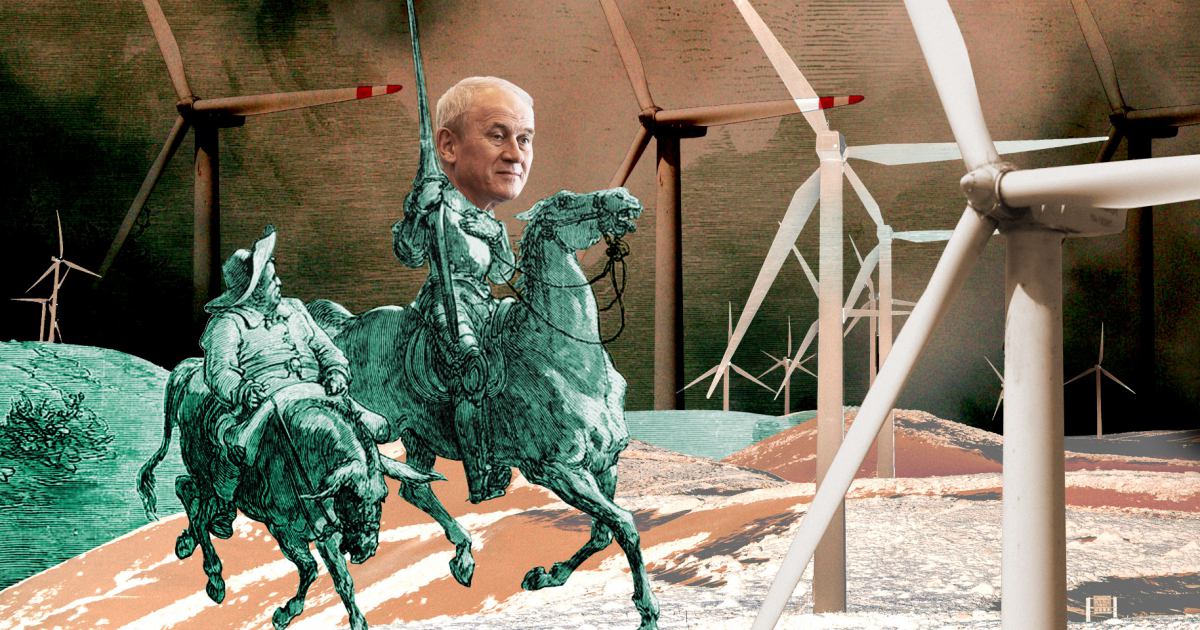
[ad_1]
A week before the international climate summit of COP24 in Katowice, the Ministry of Energy presented on November 23, 2018 the document "The Energy Policy of Poland until 2040" (PEP 2040).
In the introduction, the authors write: "It is a response to the most important challenges that Polish energy will face in the coming decades and it guides the development of the energy sector, including the tasks needed to its implementation in the short term ".
The PEP 2040 will now be subject to consultation. Comments may be submitted using a special form on the ministry's website by January 15, 2019.
Wind mill? Not on Polish soil
From this document, you will discover how the Ministry of Energy is considering changes in the energy sector in Poland. We know that the biggest challenge the world faces in this regard is the abandonment of coal and the transition to renewable energy sources that do not pollute our climate.
What does the Polish government say? Announces winding up … wind farms on the land, which is one of the largest sources of renewable energy.
Renewable energy is not just wind power – it's also water, solar energy, biofuels, geothermal energy – all energy sources that are not depleted (like oil ). And yet, the main source of renewable electricity in Poland is currently wind turbines.
According to GUS data, in 2016, they were responsible for 55%. electricity produced by RES. Geothermal energy, strongly encouraged by Rydzyk's father and former Environment Minister Jan Szyszko, is statistically invisible.
According to the "Energy Policy of Poland until 2040", all existing wind turbines must be liquidated until 2035, as well as those currently under contract and built in the coming years, a few years later.
"This dynamic growth of this technology in the energy balance is not expected as in previous years.The lack of dependence between their work and the energy demand is a major obstacle to the use of the technology. This is why the pace of their development should depend on the costs and possibilities of balancing, and the problem also lies in the diversified degree of acceptance of the wind farms by the local community ", reads the document .
At the press conference, Minister Krzysztof Tchórzewski said:
"The decline in wind power is forced by our political commitments."
It is the political promises made by some PiS MPs.
Minister of Anti-Cancer Education
Anna Zalewska, current Minister of Education, is one of the personalities of PiS in the fight against wind turbines. In 2014, when PiS was in opposition, he actively fought to limit the possibility of investing in turbines. She raised her objections to safety:
"I do not want one day the propeller of the size of the bus falls on my head"
– said PiS deputy of the time.
Zalewska has been an opponent of the creation of wind farms for years. His ally in the power camp is the director of the legal department of the Ministry of Infrastructure, Marcin Przychodzki. Przychodzki is the founder of the stopwiatrakom.eu portal, where he strongly criticizes all events promoting renewable energies and coal abandonment.
The portal explicitly writes about "climate religion" and denies climate change.
Faced with the opposition of the party, Minister Tchórzewski had to give in and now proposes ideas to limit the development of wind farms in Poland.
While Western Europe has invested over the years in this technology to reduce its costs and – to replace older wind turbines with many new generation of more efficient and more efficient new generation wind turbines – Poland is the only country of the continent to predict the total elimination of this technology and to calculate the losses. all the infrastructure that will remain after the turbines removed.
Wind on the sea of hula
The ministry does not abandon hundred percent of wind energy. In addition, he wants to increase the share of wind energy in the energy mix. How would you do it if he plans to scratch all the turbines today?
The plan described in PEP 2040 assumes that terrestrial turbines will be replaced by wind turbines at sea. The exchange must be done in about ten years. In 2016, according to data from the Energy Regulatory Office, Polish wind farms had an installed capacity of 5,800 people. MW (megawatts). The plan assumes an initial increase. According to forecasts:
- in 2020 it will be 6.4 thousand MW;
- in 2025 7,000 MW;
- in 2030 we have a decrease of onshore wind farms – 6,000 MW and more 4.6 thousand MW for offshore wind farms;
- in 2035, the forecasts assume 2.1 thousand MW in terrestrial power plants and 6000 MW in the sea;
- in 2040, he is almost gone Earth turbines (0.8 MW) and the power sea it's supposed to go up 10.3 thousand MW.
The authors of PEP 2040 assume that in the end, it gives much more energy. At sea, it blows much harder, making offshore wind farms more efficient.
54 percent energy from RES in 2040 must be the energy of wind farms. With turbines placed on the ground, only 2%.
Ambitious plans
Unfortunately, there are two problems.
First, the government has problems even with the current statements. In accordance with European Directive 2009/28 / EC, Poland is expected to reach 15% by 2020. RES electricity. In February 2018, Prime Minister Morawiecki declared that we are on the right track to achieve this goal. According to PEP 2040 forecasts, we will reach 15.2% in 2020. RES energy.
At the same time, according to the Central Statistical Office, this index has only reached 11% in 2017. In addition, there is a decrease compared to 2016, where he was 11.3%. On November 16, we wrote about the report of the Supreme Court of Accounts that devastated the renewable energy sector.
The report's authors write directly that they reach 15%. in 2020 is seriously in danger. "The lack of a consistent national renewable energy policy, delays in the publication of regulations and the lack of a stable and supportive legal environment guaranteeing the security and predictability of investments in renewable energy, especially in the electricity sector ", are to blame.
As for "stable and friendly legal environment", in July 2016, the PiS government introduced a bill called "anti-wind" by supporters of green energy. One of the assumptions of the law is that new installations can occur at a certain distance from buildings. It is ten times higher than the windmill (if the mill is 150 meters high, it must be located more than 1.5 kilometers from the buildings). In Poland, densely populated, this limits the possibility of installing new high wind turbines. Unfortunately, the most modern windmills are high.
It is clear that despite the statements and obligations – the government is not concerned about the development of wind farms – the most efficient source of renewable energy at the present time.
The second questionable question concerns offshore wind farm construction projects. It is a huge project. The assumptions presented in the Ministry of Energy's paper are the construction of wind power plants with a capacity of 4,600 people. MW between 2025 and 2030.
They are also distant projects in time. Therefore, the fear that the assumptions made for the transition of onshore wind turbines to the forefront look good on paper. In this way, the ministry presents justification for the extinction of onshore wind farms and provides a solution to the problem over time.
The PiS government has not yet proven to us that it is doing well with major infrastructure projects. However, we have evidence to support the opposite thesis – for example in the case of the construction of motorways and expressways. For several years, the pace of modern road construction has dropped significantly and the PiS government is extending the decisions on calls for bids.
Therefore, it is possible that, for fear of the Minister Zalewska against the fall of the propellers, we end up in ruined and outdated wind farms and in the absence of alternative or project.
A strange transformation
At the beginning of December, at the UN climate summit in Katowice, Poland will welcome politicians from around the world to discuss how to fight climate change together. Just before the summit, Minister Tchórzewski presents an original plan to combat global warming: slow wind farms are being liquidated ashore.
How does the ministry envision energy transformation in Poland over the next 20 years, if it wants to scrap wind turbines? The answer is to be an atom.
The plan assumes the construction of a nuclear power plant in 2033. In 2040, more than 40%. the energy must come from this source. Unfortunately, the atom is expensive. In contrast, the energy costs of wind farms are falling steadily. According to the portal wysokienapiecie.pl, the most recent wind farms produce energy that is half as expensive as the last coal plants.
The world is running away
In the long run, the Ministry of Energy predicts a sharp slowdown in the development of renewable energy technologies – by 2030, its share in the energy balance will reach 27%. and five years later … 27% In 2040, it will be 33%. PiS dreams of chasing the West, but in terms of SER, the current level of several EU countries will not catch up even within 22 years.
More than 30% of the energy used from renewable sources is the level above which there are now five countries of the European Union: Sweden, Finland, Latvia, Austria and Denmark. Poland with its 11.3% in this respect, it occupies the 21st place in the Union. Poland is below the EU level, which is 17%. By 2020, this percentage is expected to reach 20% across the EU. and in 2030 – 27%.
Each country has a designated individual objective, designated according to its capabilities. For Poland, this represents 15%, but Sweden is, for example, committed to producing 49%. RES electricity. Sweden achieved this goal in 2016, along with ten other EU countries. The result of Poland in 2016 was lower than in 2013.
International disgrace?
Poland is on track to fulfill its obligations. At the same time, he plans to abandon the current wind farms.
At the same time, the world is moving away from coal and turning to renewable energies. On Thursday, 22 November, the Irish Parliament passed a law under which the government undertakes to phase out investments in coal and fossil fuels.
For 300 days, Costa Rica has only used clean energy sources for 300 days and by 2021 it must get rid of the coal completely.
According to Wind Europe data, wind energy in the European Union preceded in turn, in 2007-2016, fuel oil, nuclear energy and hydropower, and in 2016 , the share of coal in the balance of electricity throughout the Union. Currently, wind energy is the second most common source of electricity in the EU, just behind gas. However, the dynamic development of the wind farm network suggests that the wind will soon become the European champion of electricity generation.
In the meantime, Poland is staying close to coal and already in early December, the whole world will be admired for our special approach to the fight against climate change. For the moment, on the occasion of the COP24 summit, the government has served the world with a propaganda film in which Poland is a model in the fight against climate change. Confronting viewers with accurate data can be painful.
[ad_2]
Source link
